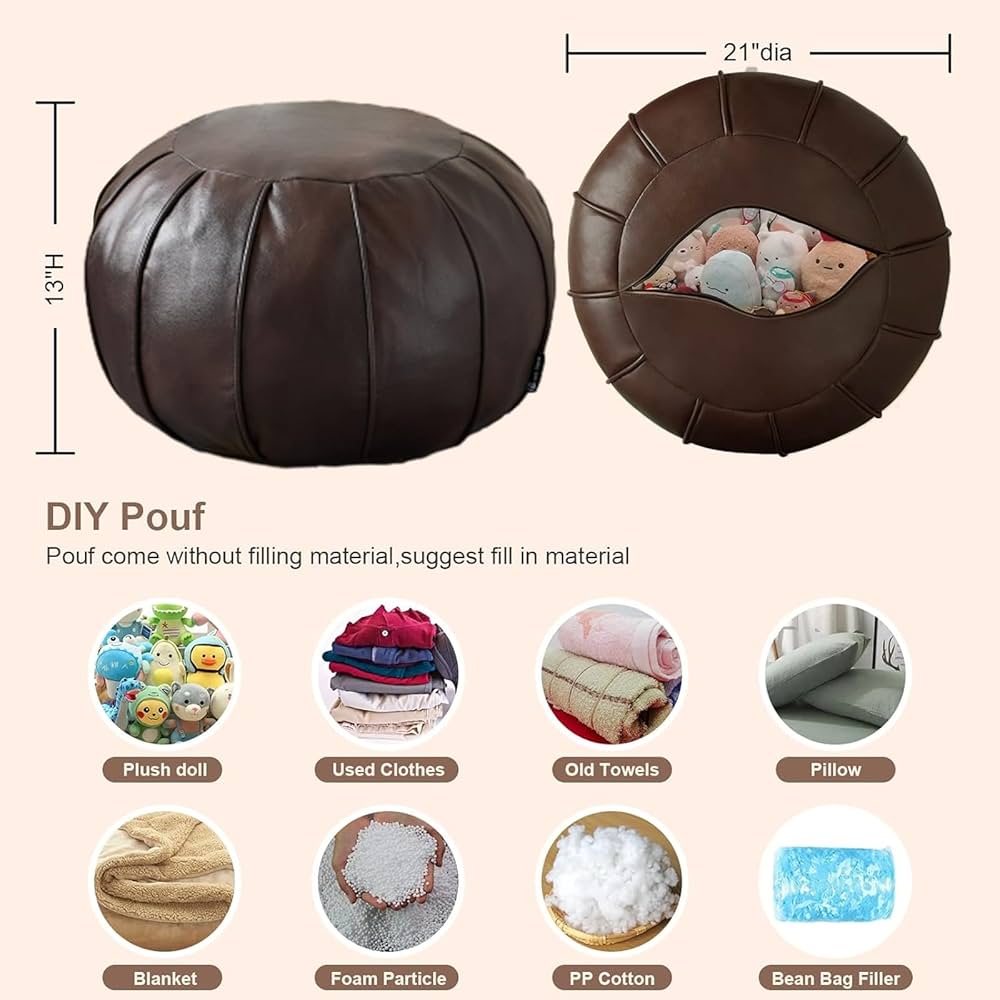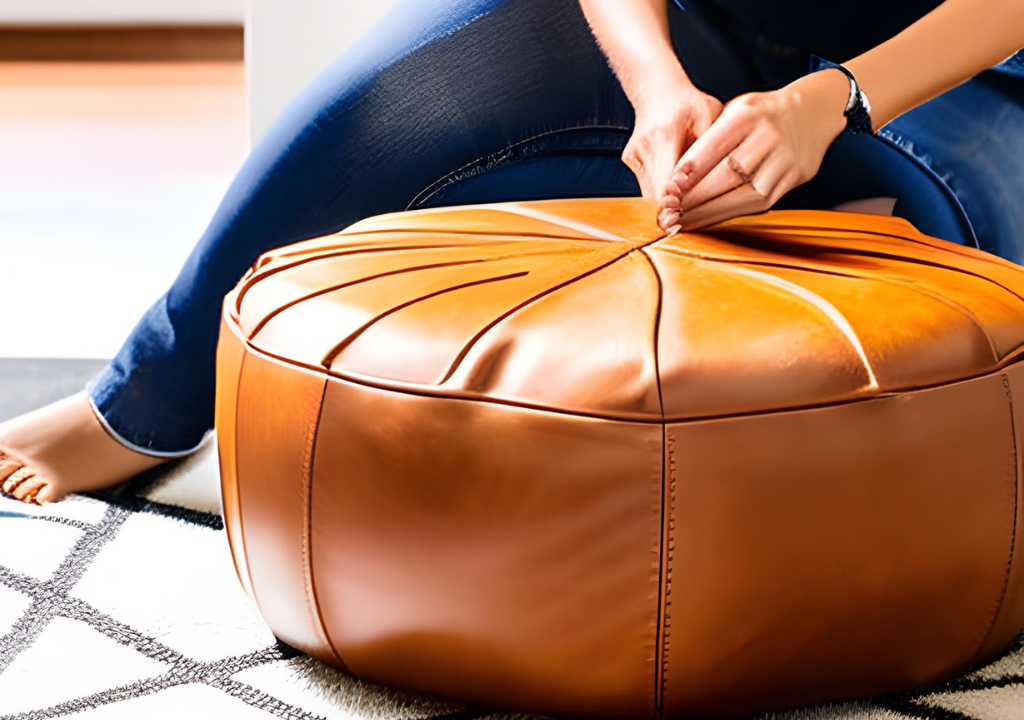Are you wondering what to use to stuff your Moroccan pouf for the best comfort and look? Choosing the right filling can transform your pouf from just a decorative piece into a cozy spot you’ll want to relax on every day.
Whether you want it soft, firm, or somewhere in between, the stuffing you pick makes all the difference. Keep reading to discover the top stuffing options that will bring your Moroccan pouf to life and fit perfectly with your style and needs.
Traditional Moroccan Pouf Fillings
Traditional Moroccan poufs are more than just decorative pieces—they carry a rich history and craftsmanship. The fillings used inside these poufs play a crucial role in their comfort, durability, and authenticity. Understanding the traditional materials can help you choose the right stuffing that keeps your pouf both functional and true to its origins.
Natural Fibers
Natural fibers have been the go-to choice for stuffing Moroccan poufs for centuries. Materials like straw, hemp, and coir offer firm support while allowing the pouf to maintain its shape over time.
These fibers are breathable, which helps prevent moisture buildup inside the pouf. Have you ever noticed how some poufs can get damp or musty? Choosing natural fibers can reduce that risk significantly.
Cotton And Wool Options
Cotton and wool are soft, cozy fillings that add a plush feel to your pouf. Wool, in particular, provides excellent insulation and resilience, which means your pouf stays comfortable through different seasons.
Cotton stuffing is easy to work with and widely available, making it a practical choice if you want a gentle, cushioned seat. You might find that cotton compresses faster than wool, though, so consider how often your pouf will be used.
Feathers And Down
Feathers and down bring a luxurious softness to Moroccan poufs, creating a cloud-like seating experience. These materials mold easily to your body, offering a personalized comfort level.
However, they require regular fluffing to maintain volume and can be less durable than fiber-based stuffing. If you value softness above all, is the extra care for feathers and down worth it for your lifestyle?

Credit: www.amazon.ca
Modern Filling Materials
Choosing the right filling for your Moroccan pouf can transform its comfort and durability. Modern filling materials offer a range of benefits, from ease of use to eco-friendliness. Let’s dive into some popular options that you can easily work with and enjoy for years.
Polyester Fiberfill
Polyester fiberfill is a soft, fluffy material that’s lightweight and easy to shape. It gives your pouf a plush feel, making it perfect for casual seating or footrests. You can find it in craft stores, and it’s simple to add or remove to adjust firmness.
One thing to keep in mind is that fiberfill may compress over time, so you might need to fluff your pouf occasionally. Have you ever noticed your cushions losing their bounce? This is a similar situation, but the good news is you can fix it quickly by adding more fiberfill.
Foam And Memory Foam
Foam offers firm support and holds its shape well, making it a favorite for poufs that get heavy use. Memory foam, in particular, adapts to your body shape, providing extra comfort. Cutting foam to fit your pouf is straightforward, and it stays consistent without much maintenance.
If you want a pouf that doubles as a sturdy seat, foam is a smart choice. Think about how often you’ll use your pouf—if it’s frequent, foam might be worth the investment. Have you tried memory foam in other furniture? It can really change how comfortable your space feels.
Recycled Materials
Using recycled materials for stuffing your pouf is a great way to reduce waste and create something unique. Shredded fabric scraps, old clothes, or even foam offcuts can be repurposed effectively. This approach can save money and give your pouf a personalized touch.
Recycled fillings can vary in texture and firmness, so combining different materials might give you the perfect balance. Do you have old textiles or foam lying around? Try stuffing your pouf with them and see how it transforms both your project and your environmental impact.
Diy Filling Alternatives
Looking to fill your Moroccan pouf with something handy? Consider DIY filling alternatives. These options are cost-effective and often eco-friendly. Plus, they are easy to find around the house.
Let’s explore some creative and practical choices for stuffing your pouf.
Old Clothes And Fabric Scraps
Old clothes make excellent pouf stuffing. They are soft and durable. Cut them into smaller pieces for even filling. Use fabric scraps from sewing projects too. This method reduces waste and recycles materials.
Plastic Bags And Packaging Peanuts
Plastic bags can fill a pouf quickly. They are lightweight and easily available. Use packaging peanuts for a firmer feel. Both are great for reusing materials that might otherwise be thrown away.
Rice And Beans
Rice and beans add weight to a pouf. They create a firm and stable base. Be sure to double-bag these materials to avoid spills. This option is practical and adds a unique feel to your pouf.

Credit: www.boucherouiterug.com
Choosing The Right Filling
Choosing the right filling for a Moroccan pouf affects both comfort and style. The filling determines how the pouf feels when you sit or rest your feet on it. It also influences the pouf’s shape and how long it lasts. Different fillings offer various levels of softness, support, and ease of care. Understanding key factors helps pick the best option for your needs.
Comfort And Support
Comfort depends on the type of filling used inside the pouf. Soft fillings like polyester fiberfill provide a plush feel. They are great for relaxing but may lose shape faster. Firmer options like foam offer strong support and keep the pouf’s shape longer. Some prefer a mix of materials to balance softness and firmness. Consider how you will use the pouf to choose the right comfort level.
Durability And Maintenance
Durability varies by filling type and affects how long the pouf lasts. Foam fillings resist wear and keep their form well. Polyester fiberfill is less durable and may flatten over time. Natural fillings like wool or cotton need more care but can last if maintained properly. Easy-to-clean fillings reduce effort in upkeep. Choose a filling that fits your lifestyle and maintenance preferences.
Cost And Availability
Cost plays a major role in deciding the pouf filling. Synthetic materials like polyester fiberfill are usually cheaper and widely available. Foam offers moderate pricing but may be less accessible in some areas. Natural fillings tend to cost more and can be harder to find. Balance your budget with comfort and durability needs. Check local stores or online shops for the best options.
How To Fill Your Moroccan Pouf
Filling your Moroccan pouf is more than just stuffing it with materials. The way you fill it affects comfort, shape, and durability. You want it to be firm yet soft, maintaining its iconic look over time. Here’s how you can get the best results.
Preparing The Pouf Cover
Start by inspecting your pouf cover for any holes or weak spots. Repairing small tears now saves you from messy stuffing leaks later. Make sure the zipper or opening is fully functional and clean.
Lay the cover flat on a clean surface to make filling easier. This way, you can evenly distribute the stuffing as you add it. A smooth start helps avoid lumps and uneven shapes down the line.
Layering Different Fillings
Think about combining materials to get the right balance of softness and support. Many people use a mix of old clothes, foam pieces, and polyester fiberfill. The clothes add weight and firmness, while fiberfill softens the feel.
Start with a base layer of denser materials like foam or fabric scraps to give the pouf structure. Then add fiberfill on top to create a plush surface. Layering helps the pouf hold its shape without feeling too hard.
- Use shredded memory foam for a comfortable, moldable base.
- Add polyester fiberfill to soften the top layers.
- Consider using recycled textiles for an eco-friendly option.
Sealing And Shaping Tips
Once your pouf is filled, close the cover carefully without forcing the zipper. If it’s tight, remove a little stuffing to avoid stress on the seams. A well-sealed pouf lasts longer and keeps the stuffing in place.
Shape your pouf by pressing and smoothing the surface with your hands. Rotate it as you work to evenly distribute the filling. Don’t hesitate to adjust the stuffing over a few days; your pouf will settle and you can fine-tune the firmness.
Have you noticed how a well-stuffed pouf instantly makes your living space cozier? What kind of filling mix do you think suits your style and comfort needs best?

Credit: medium.com
Frequently Asked Questions
What Materials Are Best For Stuffing A Moroccan Pouf?
The best materials for stuffing a Moroccan pouf include polyester fiberfill, foam beads, and recycled fabric scraps. These provide comfort and shape. Natural fillings like wool or cotton can also be used for eco-friendly options. Choose stuffing based on desired firmness and durability.
Can I Use Old Clothes To Stuff My Pouf?
Yes, old clothes are a budget-friendly and eco-friendly stuffing option. Cut them into small pieces for even distribution. This method adds softness but may compress over time, requiring occasional refilling to maintain shape and comfort.
How Much Stuffing Do I Need For A Moroccan Pouf?
The amount of stuffing depends on pouf size and desired firmness. Typically, a medium pouf requires 3 to 5 pounds of stuffing. Fill gradually, testing firmness as you go. Avoid overstuffing to prevent seams from bursting.
Is Foam Better Than Fiberfill For Pouf Stuffing?
Foam provides firmer support and maintains shape longer than fiberfill. Fiberfill is softer and more malleable but may flatten faster. Choose foam for durability and fiberfill for a plush, cushioned feel depending on use.
Conclusion
Choosing the right stuffing for a Moroccan pouf makes a big difference. Soft fills like cotton or polyester keep it comfy and light. Firm options like foam provide strong support and shape. Old clothes or fabric scraps offer an eco-friendly, budget choice.
Pick stuffing that fits your comfort and use needs. This way, your pouf stays cozy and lasts longer. Enjoy your beautiful, handmade Moroccan pouf every day.





